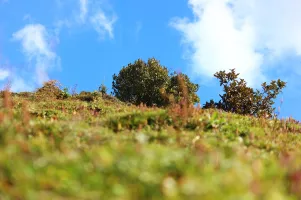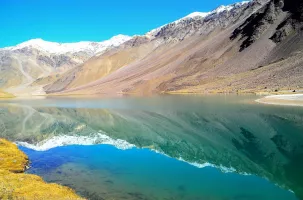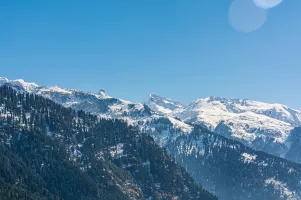Chamba
Duration
2 to 4 Days
2 to 4 Days
Best time to visit
Apr-Jun, Sep-Oct
Apr-Jun, Sep-Oct
Theme
Hill Station, Heritage
Hill Station, Heritage
Chamba Travel Guide
Chamba, located in the northern part of India, is a picturesque town nestled in the Himalayas. This destination is renowned for its ancient temples, rich history, and stunning natural beauty. The town has a significant cultural heritage, with influences from various dynasties that ruled the region. Chamba is famous for its traditional Pahari paintings, handicrafts, and vibrant festivals that showcase the local culture.Top Attractions in Chamba
- Chamera Lake
- Laxmi Narayan Temple
- Bhuri Singh Museum
- Khajjiar
- Chaugan
Chamba is Famous for
Chamba is most famous for its ancient temples and traditional Pahari paintings.Top Attractions in Chamba
- Chamera Lake
- Laxmi Narayan Temple
- Bhuri Singh Museum
- Khajjiar
- Chaugan
What's Great about Travelling to Chamba?
- Scenic beauty of the Himalayas
- Rich cultural heritage
- Peaceful and serene environment
What's Not So Great about Travelling to Chamba?
- Limited nightlife options
- Remote location may pose transportation challenges
- Harsh winters can make travel difficult
Travel Tips for Chamba
- Check visa requirements before traveling
- Prefer private transportation for local sightseeing
- Respect local customs and traditions
Important Chamba trip information
- Ideal Duration: 3-4 days
- Best Time to Visit: April to June and September to November
- Nearby Airports and Railway Stations: The nearest airport is in Pathankot, and the closest railway station is in Chakki Bank.
Per Person
19,000
*EXCLUDING APPLICABLE TAXES 3.7 Ratings
( 5 Reviews )
( 5 Reviews )
Per Person
18,000
*EXCLUDING APPLICABLE TAXES 5.0 Ratings
( 4 Reviews )
( 4 Reviews )
Per Person
16,000
*EXCLUDING APPLICABLE TAXES 5.0 Ratings
( 4 Reviews )
( 4 Reviews )
Per Person
16,000
*EXCLUDING APPLICABLE TAXES 5.0 Ratings
( 4 Reviews )
( 4 Reviews )
Per Person
15,450
*EXCLUDING APPLICABLE TAXES Per Person
16,500
*EXCLUDING APPLICABLE TAXES 5.0 Ratings
( 4 Reviews )
( 4 Reviews )
FAQ's on Chamba
Q1: What is the best time to visit Chamba?
The best time to visit Chamba is during the summer months from March to June when the weather is pleasant for exploring the region. Monsoon season from July to September brings heavy rainfall, making travel challenging. Winter, from October to February, can be cold but offers beautiful snowy landscapes for those interested in winter sports. Consider visiting during the Minjar Fair in July or the Suhi Mata Mela in April for a cultural experience.
Q2: Do I need a visa to travel to Chamba?
Travelers to Chamba need a valid Indian visa, as it is located in the state of Himachal Pradesh, India. However, citizens of certain countries may be eligible for e-visas or visa-on-arrival. It is advisable to check the latest visa requirements and regulations before planning your trip to Chamba.
Q3: What are the must-visit attractions in Chamba?
Chamba offers a rich cultural heritage and stunning natural beauty. Don't miss the Chamba Palace, Bhuri Singh Museum, Khajjiar Lake, and the Lakshmi Narayan Temples. Explore the Kalatop Wildlife Sanctuary for a glimpse of the diverse flora and fauna. Trekking in the Dhauladhar Range and visiting the ancient temples in Bharmour are also popular activities.
Q4: Is Chamba a safe place to travel?
Chamba is generally considered safe for tourists. However, like any destination, it's important to take usual precautions such as safeguarding your belongings and avoiding isolated areas at night. Stay informed about local conditions and follow any travel advisories. It is advisable to respect local customs and traditions to ensure a pleasant and safe travel experience.
Q5: What is the local currency in Chamba and can I use credit cards?
The local currency in Chamba is the Indian Rupee (INR). While major establishments may accept credit cards, it is advisable to carry cash for smaller vendors and local markets. ATMs are available in the main towns, but it's recommended to have sufficient cash on hand, especially when traveling to remote areas.
Q6: What is the local cuisine like in Chamba?
Chamba offers a delectable range of Himachali cuisine, known for its use of spices and flavors. Try dishes like Sidu, Babru, Chana Madra, and Mittha. Don't miss the local teas and snacks like Patande and Aktori. Vegetarians will also find plenty of options with dishes like Tudkiya Bhath and Kullu Trout. Be sure to indulge in the local sweets like Mittha and Chamba Chukh.
Q7: What transportation options are available in Chamba?
Chamba is well-connected by road, with buses and taxis being the main modes of transport within the region. Private taxis and rental cars are also available for exploring the area at your own pace. Public transport may be limited in remote areas, so it's advisable to plan your transportation in advance. Walking and hiking are popular options for exploring the scenic beauty of Chamba.
Q8: Are there any cultural norms or etiquette I should be aware of when visiting Chamba?
When visiting Chamba, it's important to respect the local culture and traditions. Dress modestly, especially when visiting religious sites and villages. Remove your shoes before entering temples and other sacred places. Greet locals with a "Namaste" and ask for permission before taking photographs, especially of individuals. It's also customary to accept food or drink offerings with your right hand as a sign of respect. Remember to be mindful of the environment and avoid littering in this beautiful region.
Q9: I am a travel agent. How can I buy travel leads of Chamba?
Register yourself as a travel agent at agents.tripclap.com and then you can buy travel leads to Chamba once your account is approved. For more details contact our support team at +91-8069186564 or support@tripclap.com




